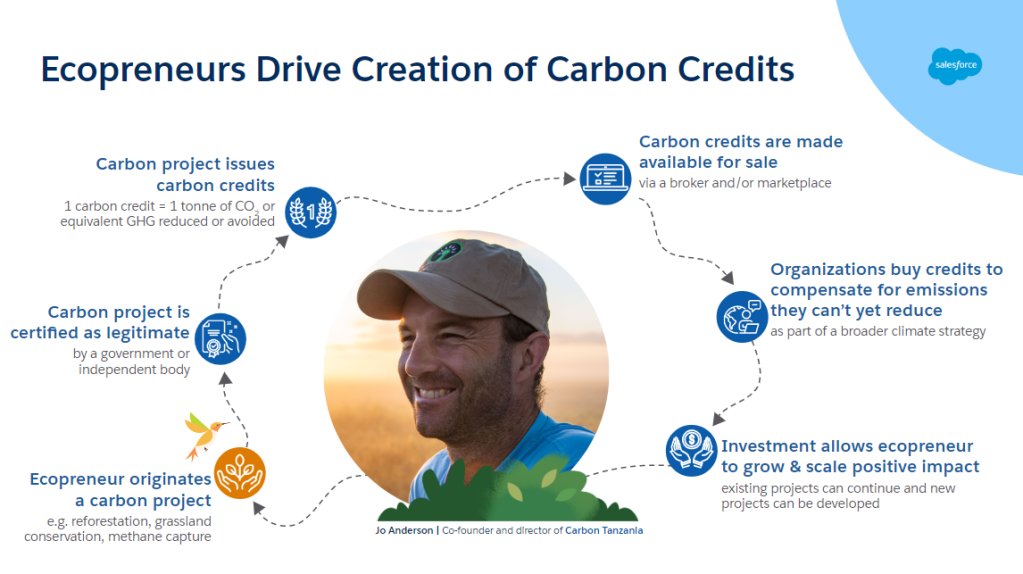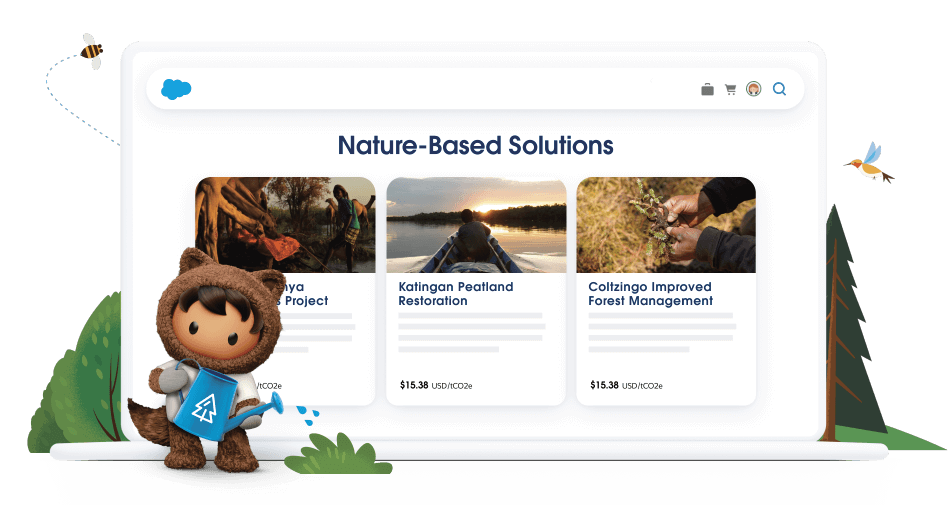What is Salesforce Net Zero Marketplace?
Nov. 7, 2022 · 6 minutes
Salesforce just unveiled Net Zero Marketplace, an open hub for people and businesses looking for direction and chances to work together while taking climate action.
The marketplace, which will go live in October, will debut with a broad selection of carbon credit offers that may be used right away to help protect the environment.
Everyone is affected by the climate problem, and every government, industry, and organization must take action.
Salesforce is known for its B2B products and services, but if you stop to think about it, we also have a strong track record of developing robust platforms that link buyers and sellers (AppExchange) and vibrant ecosystems (Trailblazer Community). Furthermore, by utilizing a dependable platform like Commerce Cloud, we were able to swiftly develop the marketplace, giving us the flexibility and scalability we need as we innovate and expand across our whole ecosystem.

What do Salesforce hope to achieve with this launch?
It's crucial to note that any organization's net zero journey must start with emissions reduction as its first goal. While concentrating on drastically decreasing its absolute scope 1, 2, and 3 emissions, each organization should set a 1.5 C-aligned, science-based target.
But in order to achieve these goals, there must be long-term societal and systemic changes. This means that while achieving emissions reduction objectives should be a top priority, businesses must look outside of their walls and learn from what others are doing well if they want to succeed. They can see ecopreneurs here, businesspeople who are interested in developing and, frequently, marketing ecologically friendly goods and services.
Salesforce's vision for Net Zero Marketplace is threefold:
- Everyone engages in climate action
- Carbon credit purchases become trusted and transparent
- We energize the “Ecopreneur” revolution and scale impact
How does the economy function? A carbon credit is what?
A carbon credit functions as a kind of license for reduced CO2 emissions. In order to make up for its emissions, a company purchases carbon credits.
So where do the carbon credits on Net Zero Marketplace come from? Ecopreneurs are businesspeople with an emphasis on the environment who spearhead and promote global climate action. Let's take my experience as an ecopreneur in Honduras as an example. My cookstove initiative helps communities switch from inefficient wood-burning stoves to cleaner models that promote community health and cut CO2 emissions from firewood.
Buyers and reputable sellers of carbon credits are linked through Net Zero Marketplace. Any organization visiting the marketplace may go to the site and, unlike many other marketplaces out there today, can clearly view prices and third-party ratings while also learning about carbon projects without having to pay or join up.
Why is a technology business in a particularly good position to start a big carbon market?
Similar to how they did when they moved to the cloud, businesses are looking for advice on how to cross the next frontier of climate action. Salesforce has acquired numerous valuable lessons in our more than five years of experience in sustainability and voluntary carbon markets that we can impart to businesses embarking on their own climate journeys.
Investors, clients, and staff all anticipate organizations to have concrete climate action plans. It affects their reputation, brand, and financial situation.
There are also businesses that are in a good position to have a real impact on the environment. Key strategic advantages include their capacity to quickly innovate and deploy capital, as well as their global presence.

These factors led to the launch of Net Zero Marketplace, along with our dedication to sustainability, which was recently declared a fundamental value at our organization.
What phase of the project's development was the most thrilling for Salesforce when it became clear that it would actually work?
Net Zero Marketplace was merely a concept in November—a bullet point on a presentation. Let's go figure this out, the Salesforce team said in plain English. After developing a plan, their developers used the Commerce Cloud platform to build a stunning proof of concept one month later.
They then began collaborating with our suppliers of carbon credits, and each of them immediately supported the notion that Salesforce was ideally situated to scale impact. I saw this was more than going to work; it was going to be great because of their values-aligned interest in achieving this together.
Net Zero Cloud Features and Benefits
- Impact on the environment SSOT
- Utilize a single, reliable platform as your sole source of information for all types of environmental data, including carbon footprint, energy consumption, and waste management.
- Targets Based on Science
- Setting targets in accordance with the Science Based Targets initiative (SBTi), a group that certifies emission goals in compliance with the Paris Agreement, will help you stay on track to reduce carbon emissions. Join the 2,000+ organizations throughout the world paving the road for a carbon-free economy, fostering innovation, and promoting sustainable development.
- What-If Analysis
- In order to confidently determine your course of action, perform scenario planning in real time based on your cost and emissions inventory and visualize the results of alternative actions. The chosen scenario can be synched in Net Zero Cloud so that you can keep track of your progress while working with important stakeholders in Slack.

- Action Dashboard for Climate (Powered by Tableau)
- Discover the combined carbon footprint of your company, including emissions from Scope 1, 2, and 3. Gaining access to the most important information will enable you to make decisions that are climate-conscious.
- Dashboard for Sustainability Audits (Powered by Tableau)
- Obtain a comprehensive understanding of the important parameters that affect your road to net zero, such as the GHG summary, energy usage, asset kinds, and emission factors.
- Impact Dashboard for Business Travel (Powered by Tableau)
- Obtain an overview of all company-wide travel emissions for hotel stays, ground travel, and air travel. To make judgments, examine travel emission statistics by division, business unit, region, or any other logical grouping.
- Supplier Management
- View all Scope 3 emissions produced by your suppliers in the value chain of procurement and gain knowledge about supplier practices that have a major impact on overall carbon emissions.
- Hub for Scope 3 Emissions
- For granular tracking of EEIO (environmentally extended input-output) and procurement data and effective management of emissions from upstream operations, track all types of Scope 3 emissions data with a dedicated app.
- Data Management for Waste
- Utilize waste data from various sources to manage waste effectively. Use predetermined emission factors to calculate Scope 1, 2, and 3 emissions, and then report on important waste indicators and KPIs.
- Records for Energy Use
- Instantaneously convert data on energy use to carbon emissions using emission conversion factors that adhere to international standards. The information is divided into Scope 1, 2, and 3 emissions, providing you with detailed knowledge of your carbon footprint.
Environmental Use Cases
- Cloud Pricing and Packaging at Net Zero
- Planning and Setting of Emissions Targets
- Utilize the target-setting and carbon-forecasting modules to create challenging, science-based goals and assess the net zero accomplishment plan on a continuous basis. Use the What-If Analysis simulation tool to decide wisely about potential emission sources.
- Real-time, precise data on carbon emissions
- Get rid of spreadsheets, keep track of your progress constantly, and produce reports in days rather than weeks or months.
- Simple Reporting
- See detailed reporting of important environmental data, such as an overview of energy use, emissions variables, and greenhouse gas (GHG) emissions.
- Corporate dashboards
- Share real-time analytics on business progress and your progress toward net zero with the C-suite.
- Stakeholder Openness
- Give shareholders, clients, and investors a truthful account of your company's environmental impact and carbon footprint.
- Supplier Participation
- Obtain more precise and timely data from 15 upstream and downstream vendors. Use emission factor databases to quantify your carbon footprint along the whole value chain for Scope 3 categories.
- Planning scenarios to reduce emissions
- Set emissions targets after simulating the effects of various choices on your carbon footprint with the What-If Analysis tool.
References
Contact Us
Contact Info
Address
Maslak Mahallesi, Büyükdere Caddesi, Nurol Plaza 255 B02 Sarıyer, Istanbul, Turkiye
Phone